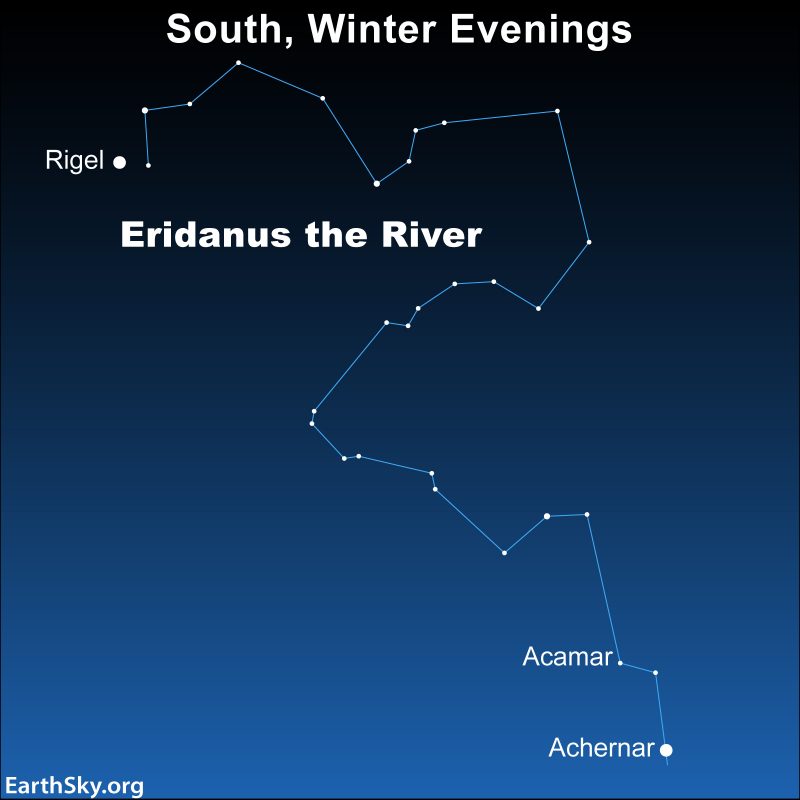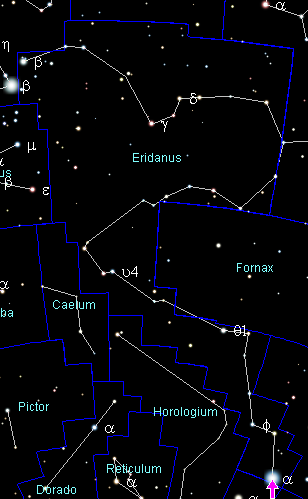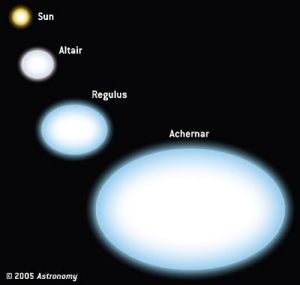
Look for Achernar from southerly latitudes
The 9th-brightest star in all the heavens, Achernar, is well known to observers in the Southern Hemisphere. But many northern stargazers know this star by its name only. That’s because – although it shines at magnitude +0.45, making one of our sky’s brightest stars – it’s extremely far south on the dome of stars surrounding Earth. If you’re north of about 33 degrees north latitude, Achernar never rises above your horizon at all. And yet this star remains one of the sky’s most famous stars as the star at the end of the River.
The River is – of course – the constellation Eridanus, which is large and easy to see in a dark-enough sky, even if you’re fairly far north on Earth’s globe. The northern part of this constellation is located near the extremely prominent constellation Orion the Hunter. Eridanus appears to swell up in a great loop near Orion, then meander southward. Finally – for most in the Northern Hemisphere – its drops out of sight below the southern horizon before it reaches its end.
But if you are far enough south – below 33 degrees north latitude – you’ll easily spot the River’s end as the bright star Achernar.
Come to know Eridanus, and someday – from some southerly latitude, maybe while on vacation – you’ll enjoy spotting Achernar!

How to see Achernar
For all practical purposes, you must be even further south – around 25 degrees north latitude – to see Achernar well. That is a line drawn around the entire globe passing through Miami in the U.S. and Taipei in China.
Nowhere in North America has it easy, seeing this star. For example, from Key West, Achernar rises only about 8 degrees above the southern horizon. Even farther south, from the southern tip of Hawaii’s Big Island, Achernar never quite makes it to 14 degrees.
And yet, if you are far-enough south, you can see Achernar easily. After all, this star is very bright!
Just as Achernar marks the end of the River, so the River has a beginning. The star Beta Eridani or Cursa, which itself is easily visible from the Northern Hemisphere, shines very near Orion’s brightest star, Rigel.
On most nights of the year, Achernar cannot be seen from anywhere in North America. However, around October 20 it skirts the southern horizon around midnight, never getting very high. Then as the months pass, it is seen earlier at night – around 10 p.m. in November, 8 p.m. in December and just after sunset in January. Being far to the south with no bright stars around it, Achernar stands out in its isolation. If you have a dark sky, and are far enough south, you’ll easily see Achernar’s constellation Eridanus making its loop under the constellation Orion.

Achernar’s history and mythology
In fact, the name Achernar derives from an Arabic phrase meaning End of the River.
Interestingly, in early classical times the name Achernar was given to the star we now know as Theta Eridani, or Acamar. At that time Acamar was the brightest star of the constellation visible from Greece, and thus was considered the River’s end.
When voyagers discovered the brighter star farther to the south, it became Achernar, and the former Achernar became Acamar.
Apparently both names derive from the same phrase, “Al Ahir al Nahr” according to Richard Hinckley Allen, whose 1899 book on Star Names (Their Lore and Meaning) is still the best around.

Science of Achernar
Data from the Hipparcos mission placed Achernar at about 144 light-years away. It is a B3V star, meaning that it belongs to the main sequence of stars.
Still, Achernar is much hotter and brighter than our sun.
In fact, it’s nearly 1,100 times as bright, visually, as our sun. Brighter, hotter (and bluer) than the sun, Achernar produces more energy in the non-visible ultraviolet (UV) wavelengths. When you take this into consideration, it pumps out some 3,000 to as much as 5,000 times the solar energy level. The discrepancy is due to an uncertainty in the amount of UV radiation it produces.
Achernar’s mass is 6 to 8 times that of our sun, and its average diameter is nearly 8 to 10 times that of the sun. But, while our sun spins on its axis once about every 25 days, Achernar completes one rotation in slightly more than two days, or nearly 15 times faster than our sun. This fast rotation produces an odd, flattened shape, first discovered by the European Southern Observatory’s Very Large Telescope (VLT) in 2003. Up close, Achernar would look more like a blue M&M, while our sun would look more like an orange. Read more about Achernar’s flattened shape from ESO.
This flattening of Achernar makes an exact surface temperature for this star hard to determine. The flattening actually causes the star’s poles to be hotter than the equator. Estimates range from about 14,500 to 19,300 kelvins (about 14,200 to 19,000 C or around 26,000 to 32,000 F).
Achernar’s position is RA: 01h 37m 42.8s, dec: -57° 14′ 12″.

Bottom line: Achernar is the 9th brightest star and flattest star known. It marks the end of Eridanus the River. Here’s why much of Earth never sees it … and how you can.
Enjoying EarthSky? Sign up for our free daily newsletter today!
The post Achernar marks the End of the River first appeared on EarthSky.
from EarthSky https://ift.tt/328it7n

Look for Achernar from southerly latitudes
The 9th-brightest star in all the heavens, Achernar, is well known to observers in the Southern Hemisphere. But many northern stargazers know this star by its name only. That’s because – although it shines at magnitude +0.45, making one of our sky’s brightest stars – it’s extremely far south on the dome of stars surrounding Earth. If you’re north of about 33 degrees north latitude, Achernar never rises above your horizon at all. And yet this star remains one of the sky’s most famous stars as the star at the end of the River.
The River is – of course – the constellation Eridanus, which is large and easy to see in a dark-enough sky, even if you’re fairly far north on Earth’s globe. The northern part of this constellation is located near the extremely prominent constellation Orion the Hunter. Eridanus appears to swell up in a great loop near Orion, then meander southward. Finally – for most in the Northern Hemisphere – its drops out of sight below the southern horizon before it reaches its end.
But if you are far enough south – below 33 degrees north latitude – you’ll easily spot the River’s end as the bright star Achernar.
Come to know Eridanus, and someday – from some southerly latitude, maybe while on vacation – you’ll enjoy spotting Achernar!

How to see Achernar
For all practical purposes, you must be even further south – around 25 degrees north latitude – to see Achernar well. That is a line drawn around the entire globe passing through Miami in the U.S. and Taipei in China.
Nowhere in North America has it easy, seeing this star. For example, from Key West, Achernar rises only about 8 degrees above the southern horizon. Even farther south, from the southern tip of Hawaii’s Big Island, Achernar never quite makes it to 14 degrees.
And yet, if you are far-enough south, you can see Achernar easily. After all, this star is very bright!
Just as Achernar marks the end of the River, so the River has a beginning. The star Beta Eridani or Cursa, which itself is easily visible from the Northern Hemisphere, shines very near Orion’s brightest star, Rigel.
On most nights of the year, Achernar cannot be seen from anywhere in North America. However, around October 20 it skirts the southern horizon around midnight, never getting very high. Then as the months pass, it is seen earlier at night – around 10 p.m. in November, 8 p.m. in December and just after sunset in January. Being far to the south with no bright stars around it, Achernar stands out in its isolation. If you have a dark sky, and are far enough south, you’ll easily see Achernar’s constellation Eridanus making its loop under the constellation Orion.

Achernar’s history and mythology
In fact, the name Achernar derives from an Arabic phrase meaning End of the River.
Interestingly, in early classical times the name Achernar was given to the star we now know as Theta Eridani, or Acamar. At that time Acamar was the brightest star of the constellation visible from Greece, and thus was considered the River’s end.
When voyagers discovered the brighter star farther to the south, it became Achernar, and the former Achernar became Acamar.
Apparently both names derive from the same phrase, “Al Ahir al Nahr” according to Richard Hinckley Allen, whose 1899 book on Star Names (Their Lore and Meaning) is still the best around.

Science of Achernar
Data from the Hipparcos mission placed Achernar at about 144 light-years away. It is a B3V star, meaning that it belongs to the main sequence of stars.
Still, Achernar is much hotter and brighter than our sun.
In fact, it’s nearly 1,100 times as bright, visually, as our sun. Brighter, hotter (and bluer) than the sun, Achernar produces more energy in the non-visible ultraviolet (UV) wavelengths. When you take this into consideration, it pumps out some 3,000 to as much as 5,000 times the solar energy level. The discrepancy is due to an uncertainty in the amount of UV radiation it produces.
Achernar’s mass is 6 to 8 times that of our sun, and its average diameter is nearly 8 to 10 times that of the sun. But, while our sun spins on its axis once about every 25 days, Achernar completes one rotation in slightly more than two days, or nearly 15 times faster than our sun. This fast rotation produces an odd, flattened shape, first discovered by the European Southern Observatory’s Very Large Telescope (VLT) in 2003. Up close, Achernar would look more like a blue M&M, while our sun would look more like an orange. Read more about Achernar’s flattened shape from ESO.
This flattening of Achernar makes an exact surface temperature for this star hard to determine. The flattening actually causes the star’s poles to be hotter than the equator. Estimates range from about 14,500 to 19,300 kelvins (about 14,200 to 19,000 C or around 26,000 to 32,000 F).
Achernar’s position is RA: 01h 37m 42.8s, dec: -57° 14′ 12″.

Bottom line: Achernar is the 9th brightest star and flattest star known. It marks the end of Eridanus the River. Here’s why much of Earth never sees it … and how you can.
Enjoying EarthSky? Sign up for our free daily newsletter today!
The post Achernar marks the End of the River first appeared on EarthSky.
from EarthSky https://ift.tt/328it7n

Aucun commentaire:
Enregistrer un commentaire